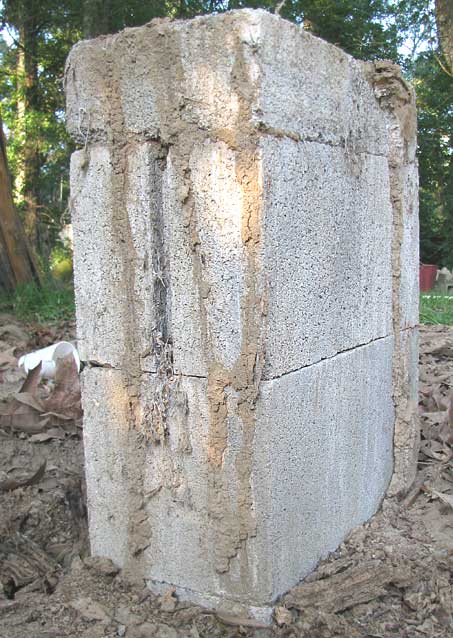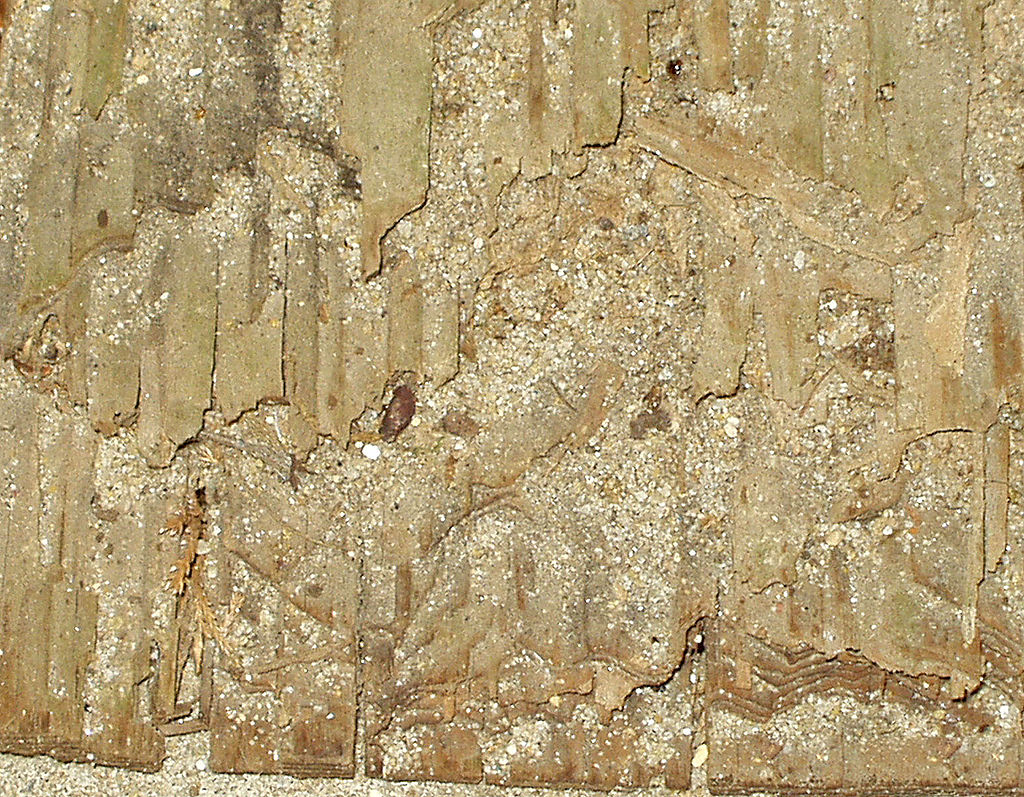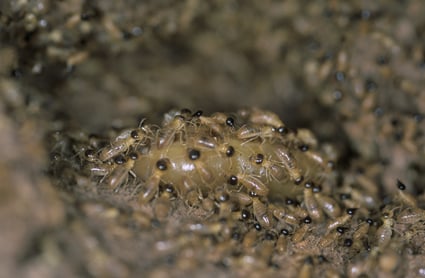Termite Inspection: How It’s Done, Cost, and More for Central & Southern MD
No one likes the nagging feeling that something is going on within the walls or in the basements of their homes, and they don’t know what it is.
Termites are one of those things. You can’t see them. You don’t really know they are there. But you suspect them. And it terrifies you.
Maybe you think you hear something in the walls. Or you could be imagining things.
Maybe you saw a winged insect in your basement and aren’t sure if it is a sign of termites lurking. Or maybe it’s just an ant with wings.
Maybe you’re thinking termites are eating you out from under your house right now. And you don’t know if it’s real or what you can do about it.
Your fear is certainly warranted. These small pests cause a lot of damage before you even realize you have a problem. Termites are present in 49 out of all 50 states, and they are known to cause $50 billion in damage to homes and buildings each year.
Worried but unsure of whether or not termites are snacking on your home? One thing can ease your concerns pretty quickly: a termite inspection.
Use This Tool to Compare Your Local Pest Control Companies
Having a termite inspector evaluate your home means he or she can spot an infestation before termites cause too much damage. Since these pests are sneaky, a thorough examination can reveal their hiding spaces. Then you can determine a better plan of attack because you’ve identified the problem and its location.
Let’s review the key elements of a termite inspection in Central and Southern Maryland, so you know how it works.
4 Pieces of Key Evidence Pros Look for During Termite Inspections
The best preventive measure against termite damage that can add up to quite a big-ticket hit to your budget is a termite inspection.
At most companies, including Natural Green, there is no cost for an initial termite inspection, unless it’s part of a home inspection for refinancing or a real estate transaction.
So, how is a termite inspection done? The process is quite simple. Once you call and request an inspection, a pro can schedule it 24 to 48 hours later. You should be home for the inspection to let the technician inside. They need access to the exterior and interior of your home, particularly vulnerable areas like crawl spaces, basements, attics, and garages.
They look for tell-tale signs of termite activity and current or even past signs of infestations. Why? Because signs of inactive damage show you that your conditions could be ripe for reinfestation. The whole inspection process could take about an hour.
Here are some of the key signs termite inspectors look for while they are assessing your home.
1. Mud Tubes
Termite inspectors look for things like mud tubes -- around ⅛” thick tubes that shelter termites as they travel between their underground colonies and your home to find wood to munch on.
Mud tubes usually extend over foundation walls or support beams. You can find these ⅛” thick tunnel trails going along wood, concrete, cinder blocks, or even in mid-air to help get the termites to their food source: wood. Think of them like termite superhighways that protect them as they move about.

2. Damaged Wood
Obviously, termite inspectors also look at your wood while they seek evidence of infestation.
Termite-damaged wood is usually hollowed out and possibly crumbling, which means if you push on it with your thumb, it might cave in because the pests have eaten out the center.
They might even find discolored or soft wood. If a pro can poke the wood with a screwdriver and it crumbles or bends under pressure, it’s a sure sign the bugs have been present and feasting.
3. Swarms
In April and May, termite inspectors may be looking for swarms.
Termites swarm, which means they move, to start new colonies. In the spring this is easier because the winged termites are able to fly into the air, drop to the ground, shed their wings, and find a mate. The emerging warmer weather and rain is their cue to swarm and begin these new colonies. The rain ensures they won’t dehydrate in the process.
Swarms near your home are a clue they are nearby. But winged termites look very similar to winged ants. Professional eyes can recognize the very slight differences between the two.
4. Termites
Yep, live termites are on termite inspectors’ checklists as well. But they are very hard to spot. There are three types of termites: workers, soldiers, and reproducers. All three are white-ish. Reproductive termites have wings that resemble flying ants. While there are some similarities in appearance, termites' wings are equal in length, while flying ants’ front wings are larger than the back set. Termites also have thicker bodies than ants.
There are three types of termites: workers, soldiers, and reproducers. All three are white-ish. Reproductive termites have wings that resemble flying ants. While there are some similarities in appearance, termites' wings are equal in length, while flying ants’ front wings are larger than the back set. Termites also have thicker bodies than ants.
If Damage is Found, There’s a Treatment That Works
If a termite inspector finds damage, they will conduct a treatment to eliminate the termites, as well as put in preventive measures to keep them away. This includes a trench-and-rod treatment that involves digging a shallow trench around the whole foundation and inserting termiticide every 1.5 to 2 feet along this trench, creating a complete barrier.
At Natural Green in Maryland, termite treatments range from between $10 to $13 per linear feet of your home’s perimeter, including any structures like garages.
The termite treatment is guaranteed, as long as owners keep up a $125 annual inspection to ensure termites haven’t broken through the barrier, as well as restrengthen areas of the barrier if necessary. These annual eyeballs on the problem are important since weather conditions and home improvements can change the way a treatment is performing around your home. Preventative termite treatments are also important to keep any worries of possible infestations or infestations at bay.
Calling in the Pros
A thorough termite inspection is worth its weight in gold. Not only does it eliminate your suspicions and fears, but it also gives you an opportunity to ask a pro all of your questions so you can feel better because you are now more informed of what the problem looks like and what should be done if termites are found.
Natural Green Systems Lawn & Pest typically finds evidence of termites in 25 percent of the homes our pros inspect.
Even for newly built homes that had preconstruction inspections done, termites are usually drawn in, depending on the cleanliness of the backfill piled around the home. If it’s filled with wood scraps, that decaying, moist wood is like filet mignon for termites. It’s not unlikely that homes only four to five years old have major termite damage, as a result.
While termites work slowly, there are nests that hold hundreds of thousands of those hungry critters. So if you suspect a problem even though everything looks somewhat solid and sturdy now, a free termite inspection can’t hurt. A little time spent with a pro is all it takes to check another possible home headache off your list.
We don’t want you to sit and worry about what’s lurking in your wood or home foundation. Give us a call today for a free termite inspection, and we’ll bring our proven termite control experience and create a custom plan for your Central and Southern Maryland home.
No one likes the nagging feeling that something is going on within the walls or in the basements of their homes, and they don’t know what it is.
Termites are one of those things. You can’t see them. You don’t really know they are there. But you suspect them. And it terrifies you.
Maybe you think you hear something in the walls. Or you could be imagining things.
Maybe you saw a winged insect in your basement and aren’t sure if it is a sign of termites lurking. Or maybe it’s just an ant with wings.
Maybe you’re thinking termites are eating you out from under your house right now. And you don’t know if it’s real or what you can do about it.
Your fear is certainly warranted. These small pests cause a lot of damage before you even realize you have a problem. Termites are present in 49 out of all 50 states, and they are known to cause $50 billion in damage to homes and buildings each year.
Worried but unsure of whether or not termites are snacking on your home? One thing can ease your concerns pretty quickly: a termite inspection.
Use This Tool to Compare Your Local Pest Control Companies
Having a termite inspector evaluate your home means he or she can spot an infestation before termites cause too much damage. Since these pests are sneaky, a thorough examination can reveal their hiding spaces. Then you can determine a better plan of attack because you’ve identified the problem and its location.
Let’s review the key elements of a termite inspection in Central and Southern Maryland, so you know how it works.
4 Pieces of Key Evidence Pros Look for During Termite Inspections
The best preventive measure against termite damage that can add up to quite a big-ticket hit to your budget is a termite inspection.
At most companies, including Natural Green, there is no cost for an initial termite inspection, unless it’s part of a home inspection for refinancing or a real estate transaction.
So, how is a termite inspection done? The process is quite simple. Once you call and request an inspection, a pro can schedule it 24 to 48 hours later. You should be home for the inspection to let the technician inside. They need access to the exterior and interior of your home, particularly vulnerable areas like crawl spaces, basements, attics, and garages.
They look for tell-tale signs of termite activity and current or even past signs of infestations. Why? Because signs of inactive damage show you that your conditions could be ripe for reinfestation. The whole inspection process could take about an hour.
Here are some of the key signs termite inspectors look for while they are assessing your home.
1. Mud Tubes
Termite inspectors look for things like mud tubes -- around ⅛” thick tubes that shelter termites as they travel between their underground colonies and your home to find wood to munch on.
Mud tubes usually extend over foundation walls or support beams. You can find these ⅛” thick tunnel trails going along wood, concrete, cinder blocks, or even in mid-air to help get the termites to their food source: wood. Think of them like termite superhighways that protect them as they move about.

2. Damaged Wood
Obviously, termite inspectors also look at your wood while they seek evidence of infestation.
Termite-damaged wood is usually hollowed out and possibly crumbling, which means if you push on it with your thumb, it might cave in because the pests have eaten out the center.
They might even find discolored or soft wood. If a pro can poke the wood with a screwdriver and it crumbles or bends under pressure, it’s a sure sign the bugs have been present and feasting.
3. Swarms
In April and May, termite inspectors may be looking for swarms.
Termites swarm, which means they move, to start new colonies. In the spring this is easier because the winged termites are able to fly into the air, drop to the ground, shed their wings, and find a mate. The emerging warmer weather and rain is their cue to swarm and begin these new colonies. The rain ensures they won’t dehydrate in the process.
Swarms near your home are a clue they are nearby. But winged termites look very similar to winged ants. Professional eyes can recognize the very slight differences between the two.
4. Termites
Yep, live termites are on termite inspectors’ checklists as well. But they are very hard to spot. There are three types of termites: workers, soldiers, and reproducers. All three are white-ish. Reproductive termites have wings that resemble flying ants. While there are some similarities in appearance, termites' wings are equal in length, while flying ants’ front wings are larger than the back set. Termites also have thicker bodies than ants.
There are three types of termites: workers, soldiers, and reproducers. All three are white-ish. Reproductive termites have wings that resemble flying ants. While there are some similarities in appearance, termites' wings are equal in length, while flying ants’ front wings are larger than the back set. Termites also have thicker bodies than ants.
If Damage is Found, There’s a Treatment That Works
If a termite inspector finds damage, they will conduct a treatment to eliminate the termites, as well as put in preventive measures to keep them away. This includes a trench-and-rod treatment that involves digging a shallow trench around the whole foundation and inserting termiticide every 1.5 to 2 feet along this trench, creating a complete barrier.
At Natural Green in Maryland, termite treatments range from between $10 to $13 per linear feet of your home’s perimeter, including any structures like garages.
The termite treatment is guaranteed, as long as owners keep up a $125 annual inspection to ensure termites haven’t broken through the barrier, as well as restrengthen areas of the barrier if necessary. These annual eyeballs on the problem are important since weather conditions and home improvements can change the way a treatment is performing around your home. Preventative termite treatments are also important to keep any worries of possible infestations or infestations at bay.
Calling in the Pros
A thorough termite inspection is worth its weight in gold. Not only does it eliminate your suspicions and fears, but it also gives you an opportunity to ask a pro all of your questions so you can feel better because you are now more informed of what the problem looks like and what should be done if termites are found.
Natural Green Systems Lawn & Pest typically finds evidence of termites in 25 percent of the homes our pros inspect.
Even for newly built homes that had preconstruction inspections done, termites are usually drawn in, depending on the cleanliness of the backfill piled around the home. If it’s filled with wood scraps, that decaying, moist wood is like filet mignon for termites. It’s not unlikely that homes only four to five years old have major termite damage, as a result.
While termites work slowly, there are nests that hold hundreds of thousands of those hungry critters. So if you suspect a problem even though everything looks somewhat solid and sturdy now, a free termite inspection can’t hurt. A little time spent with a pro is all it takes to check another possible home headache off your list.
We don’t want you to sit and worry about what’s lurking in your wood or home foundation. Give us a call today for a free termite inspection, and we’ll bring our proven termite control experience and create a custom plan for your Central and Southern Maryland home.
Image source: Mud tubes, damaged wood, Termites
Share This
No one likes the nagging feeling that something is going on within the walls or in the basements of their homes, and they don’t know what it is.
Termites are one of those things. You can’t see them. You don’t really know they are there. But you suspect them. And it terrifies you.
Maybe you think you hear something in the walls. Or you could be imagining things.
Maybe you saw a winged insect in your basement and aren’t sure if it is a sign of termites lurking. Or maybe it’s just an ant with wings.
Maybe you’re thinking termites are eating you out from under your house right now. And you don’t know if it’s real or what you can do about it.
Your fear is certainly warranted. These small pests cause a lot of damage before you even realize you have a problem. Termites are present in 49 out of all 50 states, and they are known to cause $50 billion in damage to homes and buildings each year.
Worried but unsure of whether or not termites are snacking on your home? One thing can ease your concerns pretty quickly: a termite inspection.
Use This Tool to Compare Your Local Pest Control Companies
Having a termite inspector evaluate your home means he or she can spot an infestation before termites cause too much damage. Since these pests are sneaky, a thorough examination can reveal their hiding spaces. Then you can determine a better plan of attack because you’ve identified the problem and its location.
Let’s review the key elements of a termite inspection in Central and Southern Maryland, so you know how it works.
4 Pieces of Key Evidence Pros Look for During Termite Inspections
The best preventive measure against termite damage that can add up to quite a big-ticket hit to your budget is a termite inspection.
At most companies, including Natural Green, there is no cost for an initial termite inspection, unless it’s part of a home inspection for refinancing or a real estate transaction.
So, how is a termite inspection done? The process is quite simple. Once you call and request an inspection, a pro can schedule it 24 to 48 hours later. You should be home for the inspection to let the technician inside. They need access to the exterior and interior of your home, particularly vulnerable areas like crawl spaces, basements, attics, and garages.
They look for tell-tale signs of termite activity and current or even past signs of infestations. Why? Because signs of inactive damage show you that your conditions could be ripe for reinfestation. The whole inspection process could take about an hour.
Here are some of the key signs termite inspectors look for while they are assessing your home.
1. Mud Tubes
Termite inspectors look for things like mud tubes -- around ⅛” thick tubes that shelter termites as they travel between their underground colonies and your home to find wood to munch on.
Mud tubes usually extend over foundation walls or support beams. You can find these ⅛” thick tunnel trails going along wood, concrete, cinder blocks, or even in mid-air to help get the termites to their food source: wood. Think of them like termite superhighways that protect them as they move about.

2. Damaged Wood
Obviously, termite inspectors also look at your wood while they seek evidence of infestation.
Termite-damaged wood is usually hollowed out and possibly crumbling, which means if you push on it with your thumb, it might cave in because the pests have eaten out the center.
They might even find discolored or soft wood. If a pro can poke the wood with a screwdriver and it crumbles or bends under pressure, it’s a sure sign the bugs have been present and feasting.
3. Swarms
In April and May, termite inspectors may be looking for swarms.
Termites swarm, which means they move, to start new colonies. In the spring this is easier because the winged termites are able to fly into the air, drop to the ground, shed their wings, and find a mate. The emerging warmer weather and rain is their cue to swarm and begin these new colonies. The rain ensures they won’t dehydrate in the process.
Swarms near your home are a clue they are nearby. But winged termites look very similar to winged ants. Professional eyes can recognize the very slight differences between the two.
4. Termites
Yep, live termites are on termite inspectors’ checklists as well. But they are very hard to spot. There are three types of termites: workers, soldiers, and reproducers. All three are white-ish. Reproductive termites have wings that resemble flying ants. While there are some similarities in appearance, termites' wings are equal in length, while flying ants’ front wings are larger than the back set. Termites also have thicker bodies than ants.
There are three types of termites: workers, soldiers, and reproducers. All three are white-ish. Reproductive termites have wings that resemble flying ants. While there are some similarities in appearance, termites' wings are equal in length, while flying ants’ front wings are larger than the back set. Termites also have thicker bodies than ants.
If Damage is Found, There’s a Treatment That Works
If a termite inspector finds damage, they will conduct a treatment to eliminate the termites, as well as put in preventive measures to keep them away. This includes a trench-and-rod treatment that involves digging a shallow trench around the whole foundation and inserting termiticide every 1.5 to 2 feet along this trench, creating a complete barrier.
At Natural Green in Maryland, termite treatments range from between $10 to $13 per linear feet of your home’s perimeter, including any structures like garages.
The termite treatment is guaranteed, as long as owners keep up a $125 annual inspection to ensure termites haven’t broken through the barrier, as well as restrengthen areas of the barrier if necessary. These annual eyeballs on the problem are important since weather conditions and home improvements can change the way a treatment is performing around your home. Preventative termite treatments are also important to keep any worries of possible infestations or infestations at bay.
Calling in the Pros
A thorough termite inspection is worth its weight in gold. Not only does it eliminate your suspicions and fears, but it also gives you an opportunity to ask a pro all of your questions so you can feel better because you are now more informed of what the problem looks like and what should be done if termites are found.
Natural Green Systems Lawn & Pest typically finds evidence of termites in 25 percent of the homes our pros inspect.
Even for newly built homes that had preconstruction inspections done, termites are usually drawn in, depending on the cleanliness of the backfill piled around the home. If it’s filled with wood scraps, that decaying, moist wood is like filet mignon for termites. It’s not unlikely that homes only four to five years old have major termite damage, as a result.
While termites work slowly, there are nests that hold hundreds of thousands of those hungry critters. So if you suspect a problem even though everything looks somewhat solid and sturdy now, a free termite inspection can’t hurt. A little time spent with a pro is all it takes to check another possible home headache off your list.
We don’t want you to sit and worry about what’s lurking in your wood or home foundation. Give us a call today for a free termite inspection, and we’ll bring our proven termite control experience and create a custom plan for your Central and Southern Maryland home.
Image source: Mud tubes, damaged wood, Termites
Share This
Topics: Pest Control


